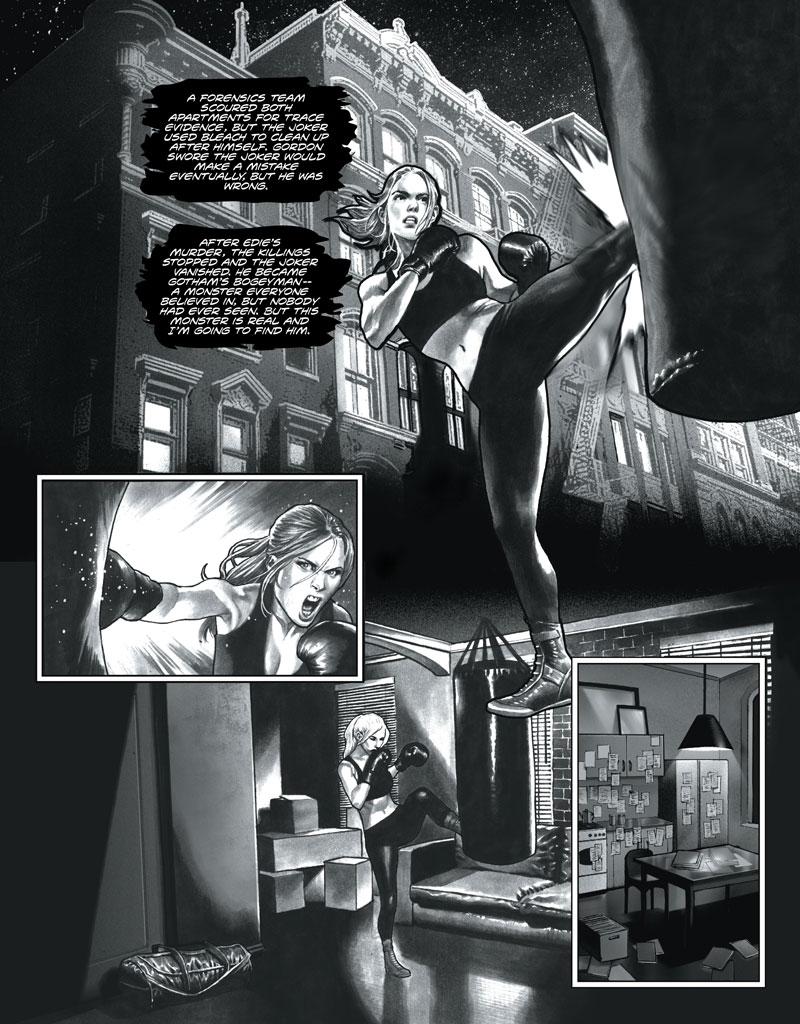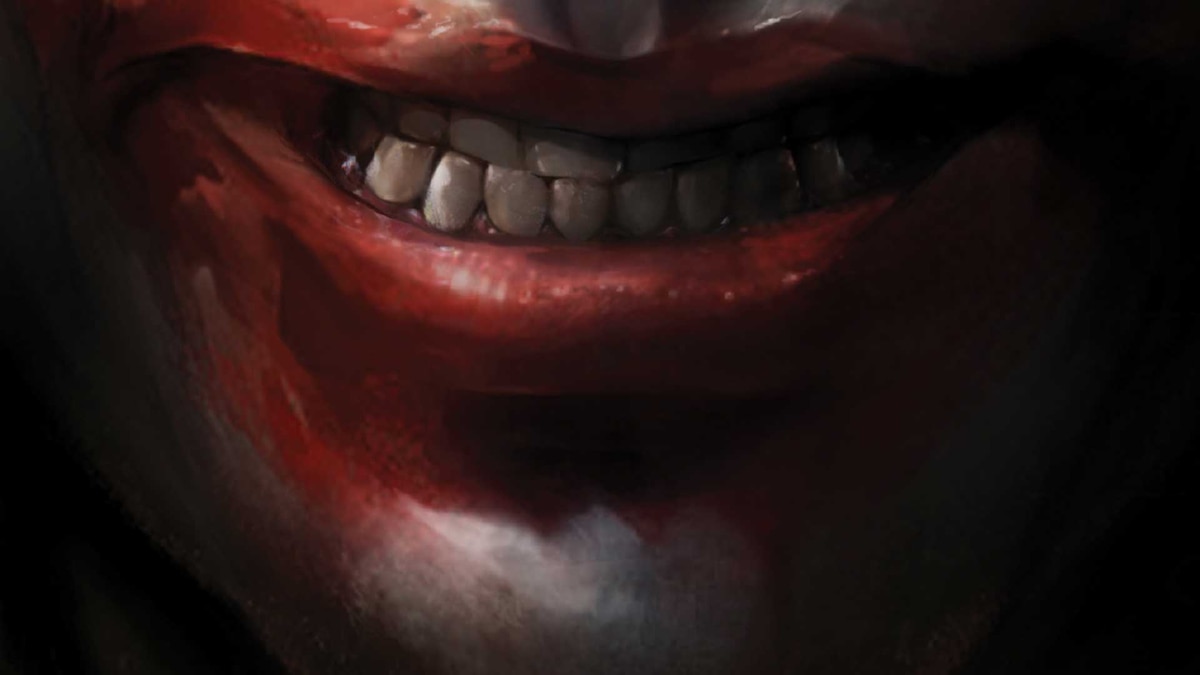You’ve seen Harley Quinn obsess over the Joker. You just haven’t seen it quite like this before.
In Joker/Harley: Criminal Sanity, the visually striking new DC Black Label series from Teen Titans: Raven’s Kami Garcia and artists Mico Suayan and Mike Mayhew, Harley is one of Gotham’s best criminal psychiatrists and profilers, but she’s haunted by the five-year-old, still unsolved murder of her young roommate. When a new string of murders show all the signs of being the work of the same person, her obsession with bringing him to justice will put her on a collision course with the city’s most terrifying serial killer—a sadistic young psychopath known as the Joker.
Borrowing from both suspense thrillers and television procedurals, the out-of-continuity Joker/Harley: Criminal Sanity is a wholly original look at the Joker and Harley dynamic and a very different sort of project from Garcia, who’s largely known for Young Adult books like the bestselling Beautiful Creatures and Raven. With its gritty portrayals of forensic science, death and obsession, Criminal Sanity represents a much darker foray into the DC Universe. So where did it come from? What inspired it? And how does writing a monthly book compare to scripting a graphic novel for the still new-to-comics author? We asked Garcia these questions and more as we sat across her, spiral pad in hand—not in a grungy police station or padded cell, but amongst the throngs of cosplayers and superfans at a recent comic con.

So, how did you go from working within our Young Adult line to writing a pretty dark DC Black Label series?
I’m a dark girl! I originally wanted to do a Joker book for the YA line. They explained to me that they weren’t doing villains, but they still said they’d like to hear the pitch. I had worked on an X-Files book, and my friend, Dr. Ed Kurz, was one of my consultants. He’s a real forensic psychiatrist profiler. I’ve always been interested in possibly writing an adult serial killer suspense novel, and Ed and I were talking about how there are psychopaths that never kill anyone. How does a boy or a girl who’s a regular kid end up becoming Ted Bundy? I was really interested in telling that kind of a story about the Joker. But the more I dug into the story, and the more that Ed consulted on it with me, it became clear that it was not going to be appropriate for YA. I really had to go dark with it. I wanted it to be true.
So, I was going to abandon it, and then Michele Wells suggested I see what I’d do with it as an adult comic. Since I was already thinking of writing an adult serial killer novel, it just seemed like there’s no one better for that than the Joker. I also started thinking about the relationship between Harley and Joker. Harley Quinn basically has a very similar job to my consultant. Dr. Kurz works in a facility for the criminally insane. One of the first things that any psychiatrist that’s going to work in that kind of a field learns is that a sociopath’s and psychopath’s manipulations are kind of obvious if you’re not a layperson. Harley isn’t a layperson. She’s a medical doctor. I wanted to play with the idea of Harley having that training and working as a behavior analyst and a profiler. What would she do with that?

Much like how the relationship between Batman and the Joker is very complex, the relationship between Harley and Joker is also very complex. I wanted to see the sane version of Joker because in a lot of iterations, he is sane. He doesn’t have hallucinations. He doesn’t have his dog telling him to kill people. He’s doing it because he wants to. To me, that’s scarier than being insane. I wanted to pit him against a profiler who was going to be equally intelligent and challenging. But again, even if you’re the best profiler, you’re still trying to catch the Joker. You know what I mean? That’s hardcore.
It sounds like you’re bringing a lot of realism to this book.
We profiled Joker as if he were a real person. I wanted to write a very accurate procedural. I wanted that psychological fear factor rather than the more gory horror fear factor. I wanted people to make sure their doors were locked after they read the issue. To really feel like he could be out there.
There are two artists on the book—Mike Mayhew and Mico Suayan. It’s been phenomenally fun to write, but it’s hard! I do a ton of research. I was working on it for almost two years before I pitched it. Then even though I felt like I had it worked out, I found I had to work out a lot more details.

Has your prose career just been YA? Or have you written darker, more adult books like this?
I was nominated for two Stoker Awards in YA, and then I’ve done a couple of short anthology pieces that were for adults. My sensibility has always stayed YA, but my consultant Ed Kurz has said that I know an inappropriate amount about serials killers for someone who’s not a serial killer or a psychiatrist.
I’ve always had this urge to write a dark serial killer book, but I think because I was a teacher for 17 years, I really know when things get too dark for the YA audience. Especially since my teen novels usually span from 12 and up. Sure, maybe a 17-year-old will be fine with it, but that’s doesn’t mean a 13-year-old is ready to see that kind of a crime scene.
But I’ve had the adult stuff kind of stirring around the back of my mind for a long time.

Was there much difference between your experience writing Teen Titans: Raven for the YA line and writing Joker/Harley: Criminal Sanity as a serialized book for DC Black Label?
It’s much harder to write a periodical. A graphic novel script is still a lot like a book to me. I like writing dialog, I love writing action, so it’s like an even more fun version of a prose novel. But a periodical is a completely different animal, and I knew that going in. I’ve read every book about how to write them. I talked to Brian Michael Bendis, who gave me a bunch of advice. I spoke with Tom King. But still, their advice makes it sound really easy because they’re amazing at it.
I had no illusions. I thought it was going to be really difficult, and it is really difficult. It’s much more like episodic television. But the thing that was most important to me was that I wanted each issue to encompass all of the different plot threads. I wanted the stakes to rise. I really wanted each issue to be better than the one before.
Molly Mahan was my original editor and Kristy Quinn is my editor now. If I didn’t have them and artists that are complete pros, there’s no way I could do this. I have to ask them questions all the time about how to make certain things work. I really look to them as the experts on the form.

Well, even though we’re talking about Criminal Sanity, I can’t let you go without asking about your other series for us. Teen Titans: Raven has been a huge hit. Where are you now on Teen Titans: Beast Boy?
Because I’m writing Joker/Harley: Criminal Sanity at the same time, I’m about halfway through Beast Boy. I’m still ahead of Gabriel Picolo, my artist, so that’s the most important thing! I’ll be done with it soon. I outline those books very extensively before I start writing, so I know what’s going to happen.
For now, I’ll be switching between the two until I get all the issues of Criminal Sanity done.
Are you used to juggling projects? Do you do this often?
Not really, but it’s easier because of the script format. I don’t love writing transitions. Writing long descriptions isn’t my favorite thing. That’s one thing I love about graphic novels—the artist is one of the storytellers. I only have to pull part of the load. They’re my partners and they’re going to bring the story to life. I think it’s shocking how talented the artists working on DC’s comics and graphic novels are. My artists are amazing. I just have to write descriptions for them, that they understand, and then I’m just doing dialog and action. It’s easy for me because I’m good at dialog. If I had to write a prose novel at the same time, I think that would be really hard. You have to get in your head a different way. I’m not a big fan of drafting a traditional novel. It’s not the part I like. Drafting graphic novels and periodicals is much more fun.

So, do you recommend people avoid reading Criminal Sanity at night?
I think it depends. It’s not a slasher story. It’s a psychological thriller with suspense. If you like that kind of stuff, then you could read it at night. But if you scare easily, you should maybe read it in the daytime.
Joker/Harley: Criminal Sanity #1 by Kami Garcia, Mico Suayan and Mike Mayhew is now available in print and as a digital download.




















